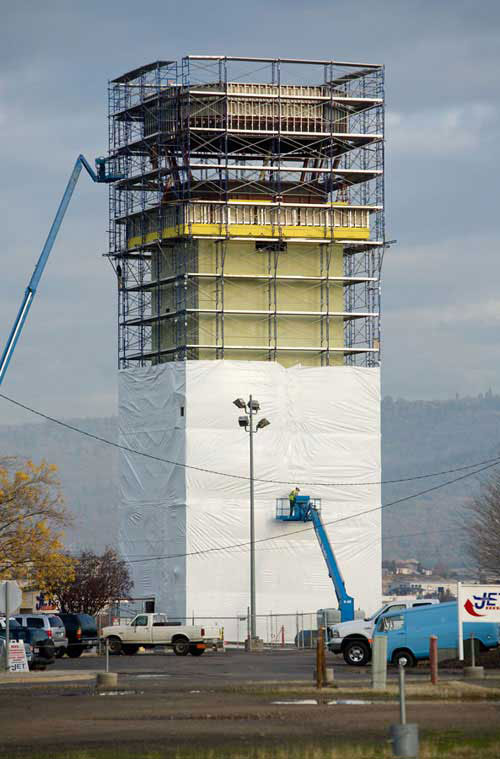What are OSHA Requirements for Scaffolding?
Apr 2nd 2021

Building scaffolds are a commonly overlooked workplace hazard. No matter how thoroughly a qualified worker has erected the scaffolding, they still pose several risks at a job site. From falling debris to human slip and falls, workers and employers should always use scaffolds cautiously. To minimize the risks associated with these structures, the Occupational Safety and Health Administration (OSHA) established some requirements that employers must follow. OSHA instituted these scaffolding standards, along with the 1996 revisions to 29 Code of Federal Regulations (CFR) 1926 Subpart L, to ensure safer work environments.
OSHA Scaffolding Regulations Overview
The OSHA scaffold regulations were first initiated in 1971, creating rules to reduce the dangers associated with these temporary structures. The OSHA scaffolding standard remained unaltered until 1996, when OSHA implemented a performance-based standard. These new additions to the OSHA scaffolding requirements allowed construction workers some leeway—they could now use personal judgment when constructing and operating on a scaffold. Instead of having catch-all OSHA scaffolding rules, the performance-based standard broke down regulations by scaffolding type and addressed scaffolds that were not previously covered.
The 1996 revisions also included the OSHA scaffolding fall protection, which increased the number of safety systems and enhanced the required training.
Most recently, a 2016 revision amended OSHA’s general industry Walking and Working Surfaces Standard (29 CFR 1910 Subpart D). Now, employers must adhere to additional OSHA scaffold safety standards found in 29 CFR 1926 Subpart L.
Construction and General Industry Regulations
The OSHA scaffolding requirements keep workers safe and hold employers liable for employee safety. These regulations touch on a few key aspects:
Training
The 1996 OSHA scaffolding regulation revisions were established after a report showed that nearly a quarter of all people who suffered scaffolding injuries had no training on safely using and navigating a scaffold.
Due to this discovery, OSHA implemented a rule that any individual who will operate on a scaffold must first be trained and supervised by a qualified individual, otherwise known as a “scaffold competent person.” This training includes how to minimize the risks and hazards associated with scaffolding work.
The OSHA scaffolding requirements don’t have an exact definition of what constitutes a competent scaffold person. However, they give some guidelines. A competent OSHA scaffolding user should have training on evaluating structural integrity and providing scaffolding maintenance. Workers can demonstrate this knowledge in the form of a certificate, degree, or professional standing.
The skills a competent person should have include:
Recognizing and reducing the risk of electrical, falling, and dropping hazards
Erecting/deconstructing a scaffold
Assembling/disassembling fall protection systems
Assembling/disassembling falling object protection systems
Navigating and operating on a scaffold
Knowledge of the maximum load capacity of the scaffold in use
Fall Protection
One of the main safety concerns addressed in the OSHA scaffolding requirements governs the rules around fall protection. Workers must implement a fall protection system at 10 feet for scaffolding. However, there are instances (such as in 1926.451(m)(1)) where a six-foot scaffold requires fall protection.
Safe Distances from Power Lines
As scaffolds are usually constructed from metal, power lines are a significant hazard. Employers and workers must adhere to several guidelines in order to use a scaffold near an energized power line. You can find these safety standards in 29 CFR 1926.451(f)(6).
Capacity Requirements
One primary consideration when working atop a scaffold is its maximum load. The entire structure is only as strong as its weakest component, so each section must be able to support—without failure—the weight of the scaffold plus a minimum of four times the intended maximum weight.
What Happens If You Don’t Comply with Regulations?
If you disregard or overlook the OSHA scaffolding requirements, you can find yourself with some hefty fines or even risking imprisonment. OSHA can charge citations and penalties against an employer up to six months after the violation was recorded. If the employer was acting in good faith, you could have these violation penalties reduced. However, willful violations will result in full penalties.
The type of violation will dictate the potential fee or penalty. These include:
Minor Violations
Violations that most likely would not have resulted in serious injury or death can be fined up to $13,494 at OSHA’s discretion.
Serious Violations
Violations that pose a serious threat of bodily harm or death result in a fine of $13,494 or more.
Willful Violations
Willful violations are when an employer knowingly commits acts that disregard the OSHA scaffolding requirements. Fines for these violations can range between $9,639 and $134,937. If a willful violation results in a fatality, the penalty can include imprisonment.
Building with Pro-Tect Plastics
There are numerous subsections to the OSHA scaffolding requirements, and understanding every aspect of it can be an arduous task. To learn more, contact OSHA.
To work with a partner who can help with all of your heat shrink plastic needs, including heat shrink tape and heat shrink film, contact Pro-Tect Plastics.

